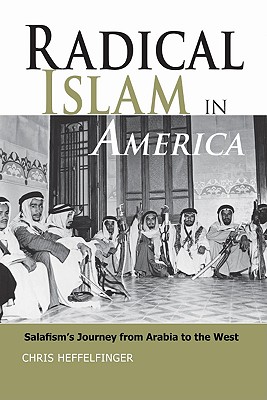
The White House’s Malnourished CVE Policy
September 15, 2011Professor Blogs ArticleThinking about terrorism this week? Wondering where anti-terrorism policy has landed? Guest blogger Chris Heffelfinger is the author of Radical Islam in America: Salafism’s Journey from Arabia to the West and a Research Fellow at the Global Terrorism Research Center at Monash University, Melbourne, Australia. He was previously an FBI Fellow who provided instruction for the FBI and Joint Terrorism Task Forces on radical Islam and terrorism at the Combating Terrorism Center at the United States Military Academy at West Point. In his book, Heffelfinger argues that the West’s failure to understand the motives behind terrorist attacks have resulted in both ineffective counterterrorism activities and the proliferation of Islamic militants and sympathizers. In this blog post, Heffelfinger argues that the first official white house policy initiative to combat terrorist radicalization will ultimately be ineffective.
 On August 3 – nearly 10 years after the 9/11 attacks – the White House released its first official policy initiative to combat terrorist radicalization. Sadly, the effort is too little, too late. President Obama is quite right to direct federal efforts toward ‘countering violent extremism’ (CVE). But this white paper, entitled “Empowering Local Partners to Prevent Violent Extremism,” is just seven pages in length and largely an outline of the radicalization problem and the broad principles the White House will use combat it.
On August 3 – nearly 10 years after the 9/11 attacks – the White House released its first official policy initiative to combat terrorist radicalization. Sadly, the effort is too little, too late. President Obama is quite right to direct federal efforts toward ‘countering violent extremism’ (CVE). But this white paper, entitled “Empowering Local Partners to Prevent Violent Extremism,” is just seven pages in length and largely an outline of the radicalization problem and the broad principles the White House will use combat it.
Even then, one must question whether the federal government bureaucracy is able to competently implement such a policy. Informally, staffers on Capitol Hill familiar with the white paper said it required months of bickering over language before it was released. Given that the document provides almost no details on how such a community-based counter extremism program would work, the US government’s time frame for carrying out this policy may simply be too slow.
Discounting the bureaucratic hurdles involved, the “Local Partners” approach was likely viewed by the White House as a safe and well-trod path for CVE policy. Policymakers and local law enforcement in the United Kingdom (UK) and Australia have been employing a community-based CVE strategy for several years. But the United States (US) would be wise to incorporate their lessons learned—this approach is not in fact as straight forward as it would seem.
Over the last five years, both the UK and Australia have implemented extensive community engagement plans as part of their wider social immersion and multiculturalism policies.1 However, this past year Prime Minister David Cameron has attacked multiculturalism, as is occasionally trendy in Western Europe, and rolled back Home Office funding for local partners. One of the UK government’s poster children was greatly affected by this – the Quilliam Foundation, a moderate Muslim London think-tank that had previously received most of its funding from the government. Motions are underway in Parliament to restore Quilliam’s funding, but the UK experience here can provide some critical lessons.
Quilliam diligently reproofed militant Islamist ideology, such as that of al-Qaeda as well as UK Salafists, but the foundation was also widely seen by British Muslims as a government lackey. Because it received such disproportionately high funding, as compared to other UK Muslim organizations, it was therefore deprived of credibility and viewed as nothing more than a tool of government policy. And in as much as perspective is reality, it was true.
I have had a number of conversations with Australian policymakers in Canberra and at the state level about this same concern – that by funding ‘moderate’ partners, governments may be undermining their own objectives by de-legitimizing those Muslim or community groups by the very act of partnering with them. But the US can sidestep this problem by creating programs that competitively offer funds to “local partners” who can demonstrate that they draw at least half of their revenue from the community they serve. Accordingly, membership-driven organizations are more likely to avoid the government lackey label should they seek federal funding. Offering funds competitively, rather than appointing certain groups as ambassadors in CVE, will also help.
In speaking with dozens of CVE practitioners in a number of countries, I have observed that community-based CVE work is done best when terrorism is not mentioned. In Melbourne, Albuquerque and London, the most effective programs are those that engage young Muslims in local traditions—a Halal meal and outing to a football game, for example. When Muslim communities are engaged solely and consistently out of security concerns, they are rightly weary of being viewed as terrorists. When they are engaged over community issues that all parties share, CVE policy objectives are more likely to be met.
But, without a doubt, countering Islamist radicalization will require more than local partnerships and community engagement. That is because the issues that compel individuals into violent jihad are not local, they are global. The prime motivation for radicalized Muslims attempting to partake in jihad is the effort to redress the oppression and suffering of Muslims overseas – in Afghanistan, Iraq, Kashmir, Chechnya, Bosnia, Southeast Asia, etc. Better gymnasiums, halal dinner banquets – even stronger anti-discrimination laws – will not address the jihadist narrative that Islam is under attack from the West. Ultimately, the US will have to engage in an actual battle of ideas and provide a credible and enduring counter-narrative to violent jihad.
1 – The US is now pursuing them under the over-arching and uniquely American principle embodied in “E Pluribus Unum”—out of many, one.
Heffelfinger has indeed given us a lot to think about. The fact that months were spent “bickering over language” before the policy’s release foreshadows a possible program failure. Bureaucracies are notoriously slow and many times ineffective, but when it comes to something as important as our national security there may be no room for the traditional delays. Possible bureaucratic delays, combined with Heffelginger’s assessment that there is a misconception on the part of the government as to what prompts an individual into a violent jihad may indicate that the policy initiative is doomed to failure. However, unlike Heffelfinger I do not believe the initiative is “too little, too late.” I do have faith in the government to learn from past mistakes and realize the need to bypass the traditional bureaucratic hurdles in implementing this policy. Also, with men like Heffelfinger around, the government will have the knowledge base required to modify the program to cater to the realities of radicalization.
You may also like
3 comments
- November 2024
- October 2024
- April 2024
- March 2024
- February 2024
- November 2023
- October 2023
- April 2023
- March 2023
- February 2023
- January 2023
- December 2022
- November 2022
- October 2022
- May 2022
- April 2022
- March 2022
- February 2022
- January 2022
- December 2021
- November 2021
- October 2021
- May 2021
- April 2021
- March 2021
- February 2021
- January 2021
- November 2020
- October 2020
- September 2020
- August 2020
- July 2020
- June 2020
- May 2020
- April 2020
- March 2020
- February 2020
- January 2020
- November 2019
- October 2019
- September 2019
- April 2019
- February 2019
- December 2018
- November 2018
- October 2018
- September 2018
- March 2018
- February 2018
- January 2018
- December 2017
- November 2017
- October 2017
- September 2017
- May 2017
- April 2017
- March 2017
- February 2017
- December 2016
- November 2016
- October 2016
- April 2016
- March 2016
- February 2016
- January 2016
- December 2015
- November 2015
- October 2015
- June 2015
- May 2015
- April 2015
- March 2015
- February 2015
- January 2015
- December 2014
- November 2014
- October 2014
- August 2014
- March 2014
- February 2014
- January 2014
- December 2013
- November 2013
- October 2013
- September 2013
- May 2013
- April 2013
- March 2013
- February 2013
- January 2013
- December 2012
- November 2012
- October 2012
- September 2012
- June 2012
- April 2012
- March 2012
- February 2012
- January 2012
- December 2011
- November 2011
- October 2011
- September 2011
- August 2011
- April 2011
- March 2011
- November 2010
- October 2010
- September 2010
It seems to me that the gist of your position is that the most successful programs work towards social integration of Muslim communities with the majority population of the country. Isn’t it possible that Muslim communities will reject this type of approach if it becomes a mechanism for blunting or obscuring Muslim identity? How can you square a program of social integration/assimilation with respect for the Muslim cultural practices? Moreover, are there precedents in America’s history that are instructive in how and how not to assimilate? For example, Italian Americans gained broad social acceptance through athletes like Joe DiMaggio, so isn’t a corresponding effort with the American public needed to make any CVE policy successful?
good point philadelphia–but what about tony shaloub? i mean are we talking arab american identity or muslim?